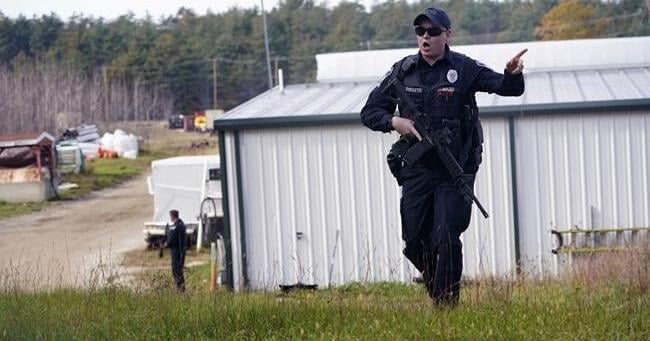PORTLAND, Maine (AP) — Thousands of pages of Maine Department of Public Safety documents released Friday contain a detailed account of the chaos and carnage surrounding the state's deadliest mass shooting.
Officers arrived at the scenes of two shootings in Lewiston last October to find surviving and dead victims lying on the floor, not knowing if the shooter was still there, and one officer said the survivors were frantically screaming for help while they searched for the shooter.
“They tried to grab us by the legs and stop us, but we were unable to help them,” Lewiston Police Officer Keith Caouette wrote. “We could only pass by, continue our search, and hope that when we returned they would be alive.”
Another officer said the heavy police presence and flashing blue lights suggested an act of domestic terrorism. “It really did feel like we were at war,” Auburn University Police Lt. Steven Gosselin wrote.
The documents describing the scene at the bowling alley and bar and grill, where 18 people were killed and 13 were injured, were included in more than 3,000 pages of documents released Friday in response to Freedom of Information Act requests by The Associated Press and other news organizations.
Associated Press reporters reviewed more than a third of the pages before the website hosting the documents went down late Friday afternoon. State officials said the documents would be available again on Monday.
Among the details included in the report was the wording of a note left by the shooter, Robert Card, a 40-year-old Army reservist, who simply wrote, “Leave the (expletive) alone,” according to the Portland Press Herald. The note also included the password to his cell phone, as well as the passwords needed to access his various accounts.
The shooter's family and fellow Army reservists reported that he had been suffering a mental breakdown in the months leading up to the shooting on Oct. 25, 2023. Following the shooting, state lawmakers passed new gun control laws in Maine, strengthening the state's “yellow flag” law, criminalizing the transfer of guns to people prohibited from possessing guns, and expanding funding for mental health crisis care.
Card's body was found in the back of a tractor-trailer on his former employer's property near Lisbon two days after the shooting, and an autopsy ruled it a suicide.
The documents released Friday contain details about what officers witnessed firsthand, as well as the extensive search and investigation into Card.
State Police Lt. Tyler Stevenson wrote that there was a heavy law enforcement presence, including, at its peak, 16 SWAT teams and officers from 14 different agencies, eight helicopters and additional planes, and an underwater recovery team.
“I have been involved in some large investigations in my career, but this was by far the largest investigation I have ever been involved in,” he wrote.
Officers used lasers to map the scene of the shooting, searched a Tracfone he had purchased at Walmart in case Card had a disposable cell phone, and retrieved data from the infotainment system in his Subaru.
Police recovered hundreds of pieces of evidence from multiple locations, including bullet casings and shrapnel, a cell phone, hair, fibers, gas pedal wipes, a handwritten letter, a tomahawk knife, an arrow, a hearing aid, broken glasses, blue sneakers, a black chain necklace, a bean bag, various military records, $255 in cash, and a night vision monocular.
The documents highlight the chaos that ensued as police swarmed the scene, responding to two crime scenes as well as unsubstantiated reports of a man with a gun in a field near the shooting scene, at another restaurant and at a massive Walmart distribution center.
“I asked who was responsible and received no answer,” Androscoggin County Deputy Sheriff Jason Shalou wrote, describing the scene outside the bar.
Monmouth Police Chief Paul Ferland said that when he arrived in Lisbon a few hours after the shooting, 60 to 70 officers were “on standby” waiting for instructions, which never came. U.S. Marshals Service officials told Ferland they hadn't been given any updates and would be pursuing their own leads.
Ferland said he had received more information from reporters outside the hospital than from police, and he retreated early in the morning out of concern for his officers' safety.
“There was a lack of communication between the agencies and it was clear that no one knew what was going on,” he wrote.
Others described horrifying scenes inside the bowling alley and bar and grill, with blood-smeared table tops, tablecloths and pool table covers serving as makeshift stretchers and cell phones ringing.
“A brief search of the premises revealed blood and flesh scattered throughout the premises,” Lewiston Detective Zachary Provost wrote about the bowling alley, “and also detected a strong odor of gunpowder mixed with burnt flesh.”
Caouette, a Lewiston police officer who responded to the bar and grill, said some witnesses yelled that the shooter was still in the building when they arrived, but others said he had already left. Caouette yelled at the man lying on the floor to “hang in there,” but when he returned he was dead.
___
This story has been updated to correct the spelling of Keith Caouette's name.
___
Lamar reported from Concord, New Hampshire. Associated Press writer Steve LeBlanc contributed from Boston.



